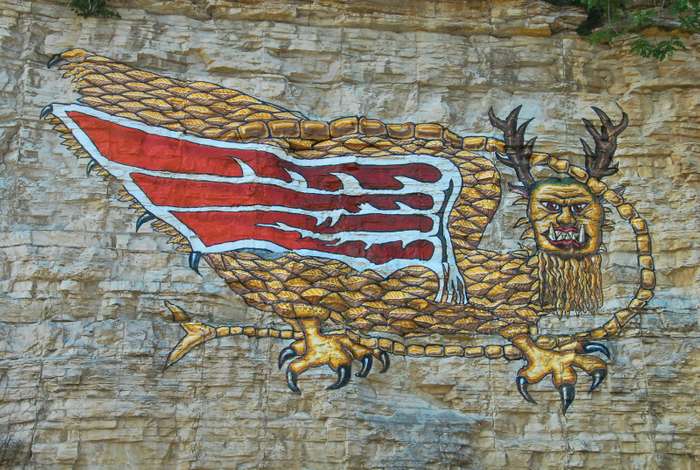
This the site for paranormal and mystery host Ginger Bridge as she explores our strange universe.


Piasa Bird Painting
Alton, Illinois is a city on the Mississippi River several miles north of St. Louis, Missouri. The area was home to Native Americans for thousands of years prior to European settlement. The myth of the Piasa Bird is alive and well in the area today, not just as a painting on a cave wall but as a deeply believed legend. Teens sneak around the area at night daring one another to go inside the local caves. Residents respect the folklore of the giant bird that once swept the skies along the river.
The first account from Europeans regarding the mythological bird is from the writings of a couple of famous explorers. Father Jacques Marquette, also known as Père Marquette, was a French American Jesuit missionary who felt it was his calling to bring Christianity to Native people. Louis Joliet was a French Canadian who studied for years to become a priest but threw in the tippet and became a fur trader instead.
The two met in 1666 shortly after Marquette’s arrival from France while Joliet was still a student at the college in Quebec. They discussed exploring the Mississippi and Marquette very much wanted to minister to the tribes who lived there. By the time Joliet asked Marquette to join him on his voyage to find the Mississippi Marquette had learned six Indian languages.
With a group of voyagers, the two paddled down the Mississippi River near the future site of Alton in 1673, they came across two large figures painted on the side of the bluff. Marquette wrote in his journal:
“As we were descending the river, we saw high rocks with hideous monsters painted on them, and upon which the bravest Indian dare not look. They are as large as a calf, with head and horns like a goat, their eyes are red, beard like a tiger’s and a face like a man’s. Their tails are so long that they pass over their bodies and between their legs under their bodies, ending like a fish’s tail. They are painted red, green and black, and so well drawn that I could not believe they were drawn by the Indians, and for what purpose they were drawn seems to me a mystery.”
This original description of the “hideous monsters” painted on the bluffs did not include wings. The wings were added later in “The Piasa: An Indian Tradition of Illinois,” written by Mr. John Russell of Bluffdale, Illinois, around 1836. Russell was a Baptist minister and professor at Shurtleff College in Upper Alton and served as editor of a local paper called “The Family Magazine.”
Russell took the name “Piasa” from the Piasa Creek which ran through the main ravine in downtown Alton in its early days. Piasa Creek has since been filled in and drainage pipes added and paved over to form Piasa Street.
According to the story published by Russell, the monster in the painting on the bluff was a huge bird that lived in the cliffs, according to Indian lore. The monster attacked and devoured people in nearby Indian villages shortly after the corpses of a war gave it a taste for human flesh. The legend claims that a local Indian chief, named Chief Ouatoga, managed to slay the monster using an idea sent to him in a dream from the Great Spirit. The chief ordered his bravest warriors to hide near the entrance of the Piasa Bird's cave, which Russell also claimed to have explored.
Ouatoga then acted as bait to lure the creature out into the open. As the monster flew down toward the Indian chief, his warriors slew it with a volley of poisoned arrows.
Russell’s cave was the so-called Bone Cave which is closer to modern day Grafton, Illinois. The Bone Cave was a real archaeological discovery, described by William McAdams in his 1887 work “Records of the Ancient Races in the Mississippi Valley.” McAdams chillingly recorded that the cave contained many bones — some of them human. Unfortunately, the Bone Cave evidently was quarried away in the early years of the twentieth century, making it impossible to investigate further in later years.
McAdams, a member of the American Association for the Advancement of Science explored the mounds in the 1880s and believed the bluffs of Madison County were an immense cemetery. They were the common burial place of the tribes who inhabited the land. Caves were discovered with accumulations of ashes showing that for long periods they were inhabited by men who lived on animals and shellfish found along the shore of the Mississippi.
The entire Alton, IL area is still full of high strangeness. There have been supposed sightings of Piasa birds well into the 21st century. One can find videos on YouTube of supposed archeological finds of bones, people who say they’ve seen one, stories passed down from family members about people who have seen one. If you’re in the area it’s pretty easy to see the cliffs where the bird was believed to have been. It’s a beautiful area near the Mississippi River, with a ton of wildlife. While no proof of the animal exists, it’s not a stretch to believe unknown species lived in the area at some point in time.
Let us know you are out there and want to be kept up to date on the newest developments here at MysteryBridge.com
Click the link below, and send us a message with the subject line, "SIGN ME UP!"